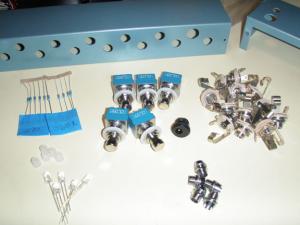Over the weekend I found myself working on a fun project. I’ve been slowly chipping away on my pedal board and one item I wanted to introduce was a bypass loop strip. I wanted this for several reasons.
– To isolate my pedals and remove them from the signal chain while not being used
– Create chained effects and activate those effects with one switch
– Create a loop for my delay
Now, I already use a Boss LS-2 for my primary lead loop which consists of Holy Fire Overdrive and Ibanez TS9 Tube Screamer, but I really wanted a loop for my Line 6 DL 4. I’ve been working on a few songs where I want to turn the delay on and off, but I loose my tempo when I do so, with this in a loop I can maintain the tempo I set throughout the song and pull it in or out.
There are lots of loop strips out there, but I wanted to see if I could build one. It was somewhat challenging to understand how the 3PDT switches work in relationship to the signal paths, and there is a lot of soldering involved, but overall, it was a easy project.
For those of you that might be interested, I documented my steps, and I’ll supply my part list for building the 5 loop strip. First though, I have to thank SingleCoil.com for writing a great article on this very subject. I used their diagram for this project and is a great resource to understand how this all works. Please check out their website. I’d also like Matt from Cheese Blocks Effects for taking a look at my project (via email) and offering some suggestions for the next build.
Okay… now to the build. First off, let’s start with a part list. I ordered everything from PedalPartsPlus.com.
1 1411TU Looper Enclosure
1 Switchcraft 1/4″ Stereo Jack #12B (I would probably not order this again and just go with 12 monos)
11 Switchcraft 1/4″ Mono Jack #11
1 DC Power Jack
5 Red LEDs (5mm)
5 5mm LED Bezels
5 Xicon 1/4watt 1* Metal Film Resistors 470 ohms
5 (CLIFF) RoHS 3PDT True Bypass Switches
#24/7 Green Wire
#24/7 Red Wire
#24/7 White Wire
#24/7 Black Wire
Tools you’ll need: wrenches, screwdriver, soldering iron, wire strippers, wire cutters, solder (I used 60/40 rosin-core .032 dia) and needle nosed plyers. It’s incredibly nice to have the ‘3rd set of hands’ alligator clips deal for soldering. Also a nice pair of wire strippers makes things easier.
This is what it looks like when I got the package. Note in this photo I have 5 560k resistors. I did not need to use those.
Next, I loosely inserted the jacks and switches. I locked in the LED bezels. I say loosely added them, because you’ll be pulling them out again. I basically put them into position so I could measure the wire lengths needed. I wanted to make sure I could open the enclosure if there was a problem. Also this enclosure is pretty tight for soldering.
Next, I thought I would work on the switches. In the diagram I was using you needed to make a ground jumper from bottom left to middle right. I first soldered the resistors for the LEDs and clipped the remaining unused lead tail and used that as the jumper and soldered that in place. I was using this diagram from SingleCoil.com (http://www.singlecoil.com/tb-strip/dia3.html).
I then started on the ground connections. Linking all the mono jacks and linking the send/receive pairs back to the the switches, as well as linking those to the master input and output of the strip. It’s important to understand the jacks and what lugs are what. Mono jacks only have ‘tip’ and ‘sleeve’. Stereo jacks have tip, ring and sleeve. The sleeve will be the ground and the tip will be your signal from the guitar. The lug (what you’re soldering to) is opposite of the tip or opposite of the sleeve. For this strip, you should be using all mono jacks since it’ll be DC powered and we don’t need to activate the current with the input jack like most pedals. For this project, I accidentally wired the signal to the sleeve of the stereo jack instead of the tip. Here is a good diagram that I was using illustrating a jack and it’s lugs: http://skyturtle.com/2009/02/17/stereo-phone-jack/
From here, I started to wire the send and returns of the effect loops as well as the DC jack.
All that is left is to connect the LEDs to the resistors and to chain the positives together. Matt from Cheese Blocks recommended that I should have used heat shrink tubing on those leads, and I definitely thought about it. In the future I’ll definitely add that to help prevent any shorts. For this project I made sure that the leads were bent up towards the lid and away from the switches as best as I could, but that little bit of shorting prevention could go a long way.
One thing that I would recommend is to make sure you clip any excess leads from wires and components, especially at the jack lugs. These jacks are very close together and could be another area of potential short circuits. Make sure you use a hot soldering iron and to focus on clean joints.
When she was all done (and after I fought the ‘sleeve’ issue with the master input) it was time to test it out. All the loops worked and everything sounded great. Here is shot of it on my board for initial testing:
Hope this comes in handy. I’ll be making another one here shortly, like to add a few more items in there.. master on/off switch, tuner out.. maybe even play with a buffered loop.








